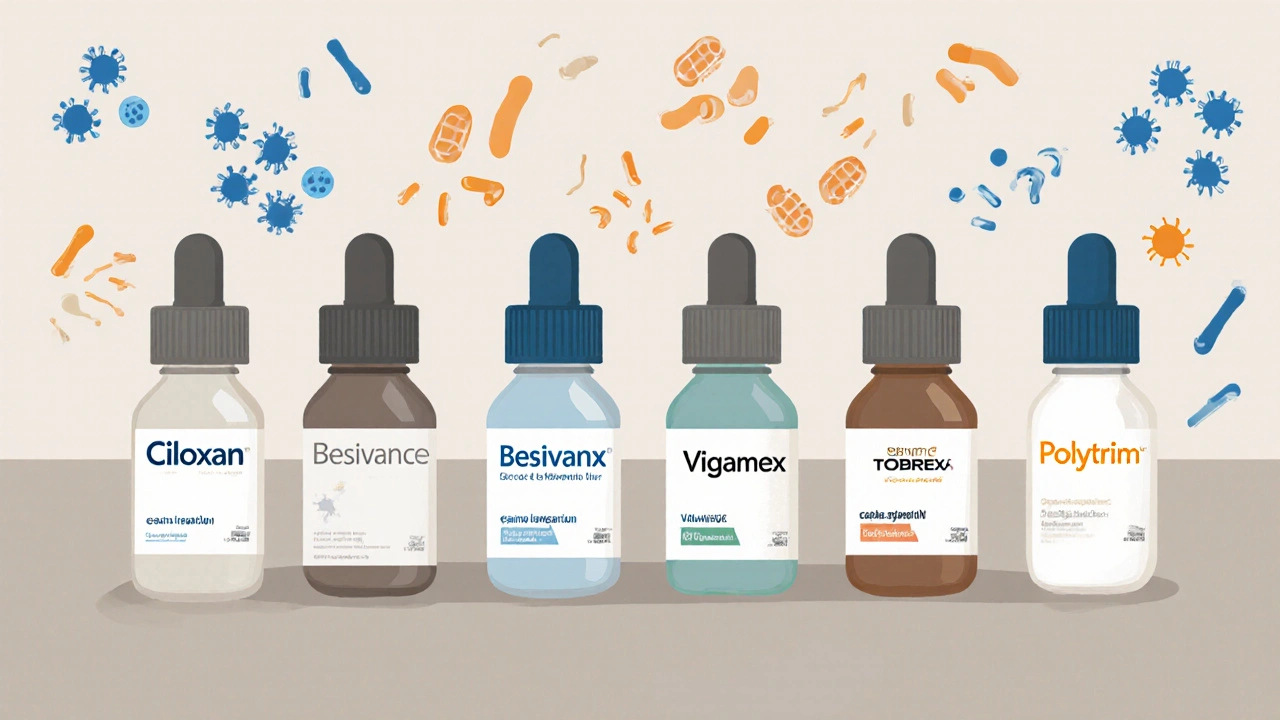
Consider: Infection type, pathogen, resistance patterns, cost, dosing convenience, and patient allergies before selecting an antibiotic.
When your eye feels gritty, red, or painful after surgery, you’re probably looking for a quick, effective antibiotic. Ciloxan Ophthalmic Solution contains ciprofloxacin hydrochloride, a fluoroquinolone that targets a wide range of ocular bacteria. But the market is crowded: newer fluoroquinolones, aminoglycosides, and combination drops each claim to be the best. This guide walks through the most common alternatives, compares key attributes, and helps you decide when Ciloxan truly shines.
Ciloxan’s active ingredient, Ciprofloxacin Hydrochloride a synthetic fluoroquinolone approved by the FDA in 1990 for ophthalmic use, works by inhibiting bacterial DNA gyrase and topoisomerase IV. The result is rapid bacterial kill across Gram‑negative and many Gram‑positive organisms. Typical concentration is 0.3% (3mg/mL) in a sterile isotonic solution, administered one drop every two hours for the first day, then tapering over 5‑7days.
Because it penetrates the cornea well, Ciloxan is a go‑to for postoperative prophylaxis, bacterial keratitis, and acute bacterial conjunctivitis. Its side‑effect profile is mild (temporary stinging, rare hypersensitivity). The biggest drawbacks? Generic pricing is decent, but some insurers place it in a higher tier, and fluoroquinolone resistance is creeping up in certain regions.

| Drug (Brand) | Active ingredient | Concentration | Typical indication | Gram‑+ | Gram‑‑ | Cost (US$ per 5mL) |
|---|---|---|---|---|---|---|
| Ciloxan | Ciprofloxacin Hydrochloride | 0.3% | Post‑op, keratitis, conjunctivitis | Good | Excellent | ≈$12 (generic) |
| Besivance | Besifloxacin | 0.6% | Bacterial conjunctivitis | Excellent | Excellent | ≈$50 (brand) |
| Vigamox | Moxifloxacin | 0.5% | Keratitis, post‑op | Excellent | Very good | ≈$30 (brand) |
| Once‑Daily OFX | Ofloxacin | 0.3% | Conjunctivitis, mild keratitis | Good | Good | ≈$15 (generic) |
| Tobrex | Tobramycin | 0.3% | Gram‑negative infections, contact‑lens keratitis | Poor | Good | ≈$8 (generic) |
| Polytrim | Polymyxin B/Trimethoprim | 0.1%/1% | Mild bacterial conjunctivitis | Moderate | Moderate | ≈$10 (generic) |
Besifloxacin is a chlorine‑substituted fluoroquinolone that boasts the lowest MIC values against resistant Staphylococcus aureus and Pseudomonas aeruginosa. It’s a once‑daily 0.6% drop, which patients love for convenience. However, the price tag is steep, and insurance often places it in a specialty tier. Use it when you suspect resistant organisms or need rapid symptom relief.
Moxifloxacin offers a slightly broader Gram‑positive coverage compared with ciprofloxacin and a handy once‑daily regimen. It’s FDA‑approved for bacterial conjunctivitis and keratitis. The cost sits midway between generic fluoroquinolones and Besivance, making it a solid middle‑ground choice when price matters but you still want a strong fluoro‑agent.
Ofloxacin’s 0.3% solution is widely available as a generic, keeping out‑of‑pocket costs low. Its spectrum is comparable to ciprofloxacin, though a bit weaker against Pseudomonas. It works well for uncomplicated conjunctivitis and mild keratitis, especially in patients who can afford multiple daily doses.
Tobramycin is an aminoglycoside that shines against Gram‑negative bugs, especially in contact‑lens‑related infections. It lacks activity against many Staph species, so it’s not ideal for postoperative prophylaxis where mixed flora are common. The drug is inexpensive and typically dosed four times a day.
This combo pairs a membrane‑disrupting peptide (polymyxin B) with a folic‑acid pathway inhibitor (trimethoprim). The synergy gives decent coverage for both Gram‑positive and Gram‑negative organisms, but the overall potency is lower than fluoroquinolones. It’s a good first‑line for mild conjunctivitis when safety and cost are top priorities.
If you’ve just had cataract surgery or a corneal procedure, you need a drug that quickly penetrates the cornea and covers both Gram‑positive and Gram‑negative bacteria. Ciloxan fits that bill without breaking the bank. Likewise, for a patient with a known allergy to aminoglycosides or polymyxin‑based drops, a fluoroquinolone like Ciloxan is the safest bet.
On the flip side, if the infection is mild, the patient is cost‑sensitive, or you have recent local data showing high fluoroquinolone resistance, you might start with Polytrim or a cheap generic ofloxacin and reserve Ciloxan for more severe cases.

In 2025, the average retail price for a 5mL bottle of generic Ciloxan hovers around $12 in the U.S., while the branded version sits near $25. Canadian pricing is generally lower due to provincial drug plans; many provinces list it as a Tier2 medication, meaning a modest co‑pay. For patients without coverage, pharmacies often offer a discount card that can shave $3‑$5 off the price.
Newer agents like Besivance can exceed $50, making them a second‑line choice unless the infection is resistant. Insurance formularies typically prefer generic fluoroquinolones, so prescribing Ciloxan (generic) often triggers the lowest tier.
Yes. Studies up to age 2 have shown no serious adverse effects. Use the pediatric dosing schedule (usually one drop every 4hours) and watch for stinging, which is common but temporary.
Most regimens run 5‑7days, starting with frequent dosing (every 2hours) for the first 24‑48hours, then tapering to 4‑6 times a day.
It’s best to remove contacts during treatment and wait at least 24hours after finishing the drops before reinserting them. This reduces the risk of trapping bacteria under the lens.
If pain worsens after 48hours, vision becomes blurry, or there’s a growing white spot on the cornea, consider a culture and switch to a higher‑potency fluoroquinolone (e.g., Besifloxacin) or an agent with better Pseudomonas coverage.
Topical use has a negligible systemic absorption, so tendon rupture is extremely rare. The warning primarily applies to oral or IV fluoroquinolones.
Talk to your eye care professional about the specific infection you’re dealing with. Bring up any cost concerns - many pharmacies can offer a generic cutter that makes Ciloxan even more affordable. If you’ve tried Ciloxan and symptoms persist, ask for a culture and consider stepping up to a newer fluoroquinolone or a combination drop.
Remember, the right antibiotic depends on the bug, the patient’s situation, and the price tag. Use this comparison as a roadmap, not a prescription, and you’ll land on the most effective, budget‑friendly option for your eyes.
Write a comment